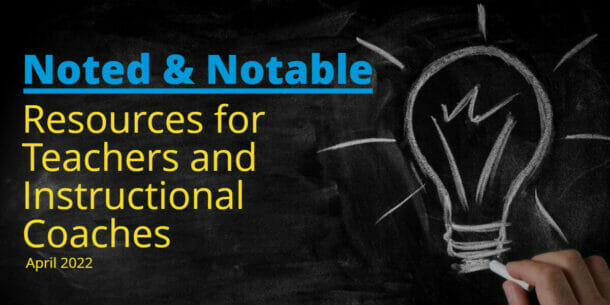Resources for Teachers and Instructional Coaches – April 2022

Spring is in full swing, and whether you’re conducting an end-of-year teacher self-reflection or thinking about giving effective feedback, we’ve got the latest reads for you.
This edition of noted and notable content for educators includes three popular education articles about supporting teacher and coach growth.
Here are our top picks for the Apr. 2022 reads you shouldn’t miss. Read on for the highlights, article links, and related content.
Improve teaching practices with more teacher self-reflection
Teachers and instructional coaches know that in order to strengthen effective teaching, teachers should regularly reflect on their practice.
This Edutopia post notes, “Without reflection, teachers could be potentially trapped in a cycle of unexamined judgments, assumptions, and misinterpretations about their teaching. Further, research indicates that when teachers reflect on their practice, they develop their self-efficacy. … Increased teacher self-efficacy has been shown to increase student achievement.”
Springtime, with the end of the school year approaching, is an especially ideal time for teacher self-reflection.
Reflection is most effective when it is a cyclical process with these three components:
- First, teachers must identify a problem they want to address. Problem-solving means reflecting on situations that didn’t go well and then coming up with solutions to address the issue.
- The second area of reflection is raising awareness about one’s own strengths and weaknesses as a professional educator. Teachers need to reflect often on what they’re doing well and areas they need to strengthen because as good as we may be, there’s always room for development.
- The last component of reflective practice is constructing professional knowledge through both formal and informal teaching networks. Professional knowledge consists of an in-depth understanding of subject matter, curriculum, instruction, assessment, and knowledge of students and their communities to raise student achievement.
Read the full post at Edutopia for more about best practices for teacher self-reflection: How To Refine Your Teaching Practice With Springtime Reflection
Teachers, thinking about doing some self-reflecting? Here’s your guide to end-of-year teacher reflections.
Instructional innovation starts with teacher buy-in
Implementing new school initiatives can often feel frustrating for educators to adopt.
This Edutopia article outlines five steps for coaches and instructional leaders to enhance “instructional innovation.”
- Pinpoint key instructional challenges.
This step requires school or district instructional leaders to discuss enhancing instructional innovation and to learn about the needs of their schools. … It’s best not to make decisions about teachers without some in the room.- Observe current instruction through learning walks.
The team must ensure that classroom observations are well received by the teachers. The intent of instructional innovation and the problem statement must be shared with teachers to include them as stakeholders and to earn trust.
- Hold a data debrief and conjure up solutions.
Together the team should discuss the data obtained during the learning walks and begin to identify possible solutions and barriers to the actualization of the problem statement in step one.- Design professional development (PD) solutions.
This often includes targeted and embedded PD solutions in strands and milestones. Strands for tiered curriculum design and facilitation strategies should differently support administrators, beginning teachers, and seasoned teachers.- Implement PD using data.
Following the implementation of each PD strand and milestone, the team collects more data from participants to evaluate effectiveness.
Read more at Edutopia: A 5 Step Coaching Model for Instructional Innovation
Five characteristics for effective instructional feedback
Teachers want feedback. But what kind of feedback is actually helpful?
If you’re a coach thinking about what is most effective for improving your teachers’ instruction, here is what the research covered in this ASCD article says about the most valuable feedback for teachers.
Teachers want feedback on student learning.
In particular, teachers want to know: Do my explanations make sense to students? Are even reluctant students engaged and catching on? Are all students feeling that they are part of the class and involved in something meaningful?Teachers want feedback from their students in their classes.
The feedback on student learning that teachers find most useful, according to our survey (and many other studies), is personalized for them and designed to help them succeed in their context. Teachers want ideas that will enhance interactions with the students they see daily in order to gain personal “mastery experiences” that show they make a difference (Bandura, 2001).Teachers want feedback they trust.
Teachers trust the results from students’ daily work, personal interactions and observations of students, student presentations and demonstrations, and classroom assessments in their classrooms (Guskey, 2007).Teachers want feedback quickly.
This means the process of implementing a new practice or strategy must establish procedures for teachers to gain feedback on their efforts’ results within weeks, not months or years.Teachers want feedback offered in meaningful, non-threatening ways.
How leaders communicate that feedback matters to teachers. Strong evidence shows that if teachers don’t receive feedback in meaningful, helpful, and non-threatening ways, their practices will not change (Cherasaro et al., 2016)
Read more about what the research shows on feedback for teachers at ASCD: What Teachers Really Want When It Comes to Feedback
Coaches, trying to give good feedback without ensuring teachers feel safe? Check out this blog post for four coaching best practices so you can give the most effective feedback.
Missed last month’s edition of resources for teachers and coaches? Catch up on our Mar. 2022 top resources for teachers and coaches!
